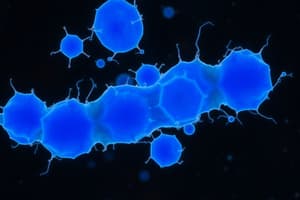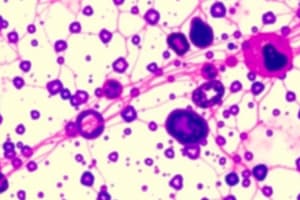Podcast
Questions and Answers
What is the primary purpose of acid-fast staining?
What is the primary purpose of acid-fast staining?
- To differentiate between Gram-positive and Gram-negative bacteria
- To enhance bacterial growth
- To identify acid-fast microorganisms (correct)
- To identify spore-forming bacteria
Which reagent is NOT used in acid-fast staining?
Which reagent is NOT used in acid-fast staining?
- Alkaline methylene blue
- Methanol (correct)
- Carbolfuschin
- Acid alcohol
What color do acid-fast bacilli appear after the staining process?
What color do acid-fast bacilli appear after the staining process?
- Green
- Blue
- Bright red (correct)
- Brown
During decolorization, what indicates that the slide has been adequately treated?
During decolorization, what indicates that the slide has been adequately treated?
Why is it essential to prevent boiling during the staining process?
Why is it essential to prevent boiling during the staining process?
How long should the carbolfuschin be heated on the slide during staining?
How long should the carbolfuschin be heated on the slide during staining?
What is the correct order of steps after rinsing with water following decolorization?
What is the correct order of steps after rinsing with water following decolorization?
What type of microscope objective should be used to examine the slide after staining?
What type of microscope objective should be used to examine the slide after staining?
Which of the following bacteria can also be identified through acid-fast staining besides Mycobacteria?
Which of the following bacteria can also be identified through acid-fast staining besides Mycobacteria?
What is the consequence of allowing the slide to dry out during the staining process?
What is the consequence of allowing the slide to dry out during the staining process?
Flashcards
Acid-Fast Staining
Acid-Fast Staining
A staining technique used to identify bacteria with a waxy cell wall.
Mycobacteria
Mycobacteria
Mycobacteria species are a type of bacteria that possess a waxy cell wall, making them difficult to stain with traditional methods.
Heat-Fixing
Heat-Fixing
The process of heating a smear during staining to enhance the penetration of dyes.
Ziehl's Carbolfuschin
Ziehl's Carbolfuschin
Signup and view all the flashcards
Acid-Alcohol
Acid-Alcohol
Signup and view all the flashcards
Methylene Blue
Methylene Blue
Signup and view all the flashcards
Acid-Fastness
Acid-Fastness
Signup and view all the flashcards
Acid-Fast Bacilli
Acid-Fast Bacilli
Signup and view all the flashcards
Nocardia
Nocardia
Signup and view all the flashcards
Oil Immersion
Oil Immersion
Signup and view all the flashcards
Study Notes
Acid-Fast Staining Procedure
- Acid-fast staining identifies acid-fast microorganisms, like Mycobacteria species, and some other bacteria (e.g., Nocardia).
- Also known as Ziehl-Neelsen staining.
- Uses carbolfuschin, acid alcohol, and methylene blue.
- Acid-fast bacilli appear bright red after staining.
Procedure Steps
- Smear preparation: Mix microorganisms and air dry, then heat-fix the smear.
- Carbol-fuschin application: Place slide on a heated plate (covered with paper towel) and saturate with carbolfuschin. Heat for 3-5 minutes, avoiding drying or boiling. Alternatively, use a water bath with staining rack.
- Water rinse: Rinse the slide with water for 30 seconds.
- Decolorization: Carefully add acid-alcohol dropwise until slight pink remains (10-30 seconds).
- Second water rinse: Rinse with water for 5 seconds.
- Counterstain: Stain with alkaline methylene blue for 2 minutes.
- Final water rinse: Rinse with water for 30 seconds.
- Drying: Blot the slide dry with bibulous paper.
- Observation: Examine under oil immersion.
- Result interpretation: Acid-fast organisms are red; other organisms are blue or brown.
Studying That Suits You
Use AI to generate personalized quizzes and flashcards to suit your learning preferences.




